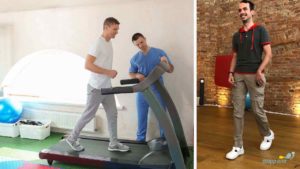Gait analysis: stapp one versus treadmill

Treadmills are often used for gait analysis in order to assess the gait pattern or to obtain dynamic foot pressure load measurements. The aim is to have a holistic picture of the musculoskeletal system and to identify possible deficits. However, it has been proven that treadmills change the gait pattern and can therefore produce distorted analysis data. stapp one, however, is not restricted to any one location and therefore allows to analyze gait behavior in scenarios that are relevant in everyday life.
Gait analysis plays an important role in many areas. For the upright gait a complex system in the body works together, that can be affected in various ways. One way due to injuries, which is especially a topic in sports medicine. Another way when it comes to neurological diseases where gait analysis is an important assessment in the diagnosis or even rehabilitation.
Problems with gait analysis on the treadmill
One of the problems with using a treadmill for gait analysis is that it does not result in natural everyday movements. This is because when walking on a treadmill the ground moves. Under normal circumstances people intuitively choose the appropriate walking speed but on a treadmill the pace is predetermined. As a result, patients have to concentrate very hard to maintain the preset walking speed. This stands in contrast to normal walking, where the pace differs and sometimes you walk faster and sometimes slower, depending on the surface and direction. This is especially problematic for people who are not used to treadmills this assessment is challenging and has a huge impact on the gait pattern.
Clear distortion of the gait pattern
The distortion of the gait pattern on the treadmill is also clearly evident in stride length and stride frequency, that change significantly. On the treadmill, for example, the stride length is shorter and the stride frequency is higher. The gait lines are also significantly wider than in normal gait. This was investigated in a study by graduate physicist Günther Hegewald.
“Compared to a treadmill, when overground running the gait is relatively wide. Fluctuations of the body’s center of gravity transverse to the direction of gait are corrected by slight changes in direction. However, on the treadmill, which is usually very narrow the correction is mainly made by compensating movements of the leg stance, which is noticeable by a widening of the gait line.”
stapp one provides real-life data
Unlike a treadmill, stapp one’s intelligent sensor sole is a smart alternative or addition to stationary gait labs. The sensor sole measures the foot pressure load, body center of gravity and many other time-based gait parameters. The soles are simply inserted into comfortable shoes and can be used wirelessly for any type of gait assessment, regardless of location. The correspondent medical software additionally enables the visualization of a live biofeedback on a tablet or laptop. The initial setup takes only a few seconds! Without distorting the actual gait pattern, stapp one can be used to perform gait analyses on a wide variety of surfaces – outdoors, indoors or even while climbing stairs.
Are you interested in using stapp one? Please contact us! We are at your disposal at any time.
Find us on LinkedIn and become part of our community! We keep you updated about stapp one, medicine and technology!
¹ Hegewald, Günther. 1999. Ganganalytische Bestimmung und Bewertung der Druckverteilung unterm Fuß und von Gelenkwinkelverläufen. Dissertation. Institut für Rehabilitationswissenschaften. Humboldt Universität zu Berlin. S. 85.

